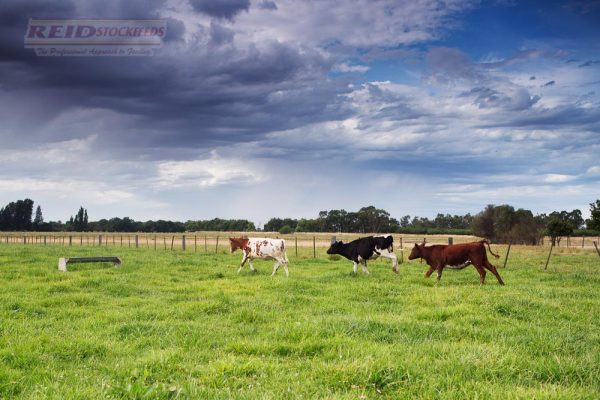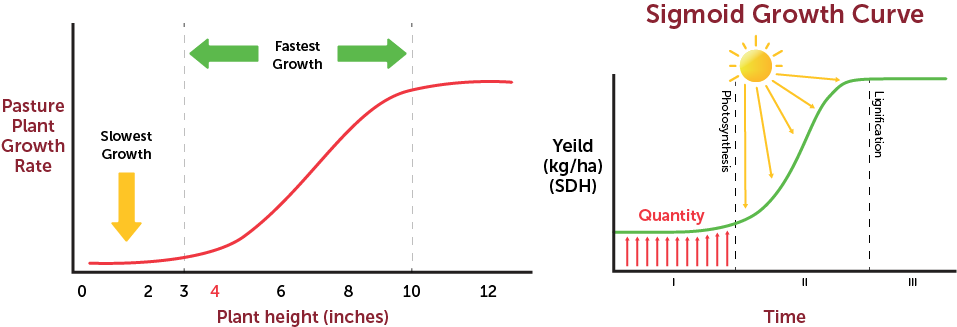Slowing down the grazing rotation
We know from countless studies that pastures are very slow to recover from grazing until they reach 1 ton of dry matter per hectare (DM/Ha) and slow down substantially once they get over 2.5 tons DM/Ha. 1 ton DM/Ha is heal height on a standard work boot and 2.5 tons DM/Ha is canopy closure height or just over the top of your work boot. We can use this knowledge to avoid over or under grazing pastures and slowing down pasture growth. We should aim to keep pastures above 1.2-ton DM/Ha post-grazing and not much taller than 2.3 tons DM/Ha pre-grazing, in doing this we maintain maximum growth rates all year round (even in summer and autumn). Keeping pastures in the maximum growth rate zone is referred to as “Grazing the Pasture S Curve” as illustrated in the images below.
By adhering to this advice, we will harvest just over 1 ton DM/Ha. Using this information, we can understand of how much pasture we are offering our cows each time we graze a pasture. The formula is:
1000 kg D.M./Ha multiplied by Number of hectares divided by Number of cows grazing the paddock. E.g., Farmer Joe’s cows graze 1,000 kg D.M./Ha and he offers 2.5 hectares, then 300 cows would be offered 8.3 Kg/D.M. per feed each.
How regularly should you graze a paddock?
This is easy to calculate. First, take another look at the graph on the first page. On the vertical axis, it shows DM/Ha growth per day. The formula is:
1000kgDM/ha divided by Pasture growth rate (see graph here) = Days till next grazing
E.g., In August, the average growth rate is 20 kg DM/Ha/day. If we harvest 1,000 Kg DM/Ha per grazing, we need to allow 50 days post grazing for the pasture to recover. In September, the average growth rate increases to 40 Kg DM/Ha/Day it would take 25 days for the pasture to recover from a grazing and get back to 2300 Kg DM/Ha on offer.
Managing pasture rotations are as simple as that, but it only works if you are grazing according to the Pasture “S” Curve. You can use pasture residuals post grazing as a check that you are getting it right. Cows have big lips, and these big lips prevent cows from grazing much below 900 kg pasture per hectare. However, the growth rate from 900 kg to 1200 kg is awfully slow (see below). If you intend to deliberately slow down pasture growth post grazing by 10-15 days then the best way to achieve this would be to graze your pastures hard to the point that they are “skun-out” completely (900kgDM/Ha). If the rotation needs to be 50 days in August to match expected growth rates, you are more likely to need to reduce the area of pasture on offer, not increase it.
If you are feeding less grass today, so that you have more to give in September then, you might need to increase hay or silage to be sure the cows are fully fed. Hay and silage can be a tool to indicate correct grazing residuals. By offering slightly more fodder than the cows are capable of eating you ensure they are full, please don’t think of any left-over pasture or fodder as waste.
True waste is limiting potentially rapid pasture growth to sluggish pasture growth because you have grazed too hard, and your rotation is too fast.
Conserved fodder does not have a lot of milk in it, feed in the dairy has a roll to play in balancing the ration. Your Five Star / Reids representative can help you balance the ration and maximise your profitability.

